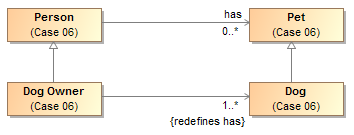Sometimes, in the context of some class, it is necessary to constrain all the values of a property to a particular type. This constraint is known as a universal quantification or for-all constraint (∀). This kind of constraint is an assertion that only values of the specified type are valid, and that the number of values must be between some minimum and maximum cardinality. In the concept modeling interpretation of UML, introducing a new property or redefining an existing property creates a universal quantification constraint in the context of the owning class. This interpretation is based on {redefines} in UML, which allows adding more specific constraints to an existing property without defining a new property.
The diagram below shows the introduction of a new property, “consists of”, defining a universal quantification constraint on the property. The constraint states, in the context of Soccer Team and any of its subclasses, that all values of this property must be of the type “Soccer Player”, and that there must be between 5 and 11 values of this property.

Figure 1: The property 'consists of' defining a universal quantification constraint.
The following diagram shows a universal quantification constraint on the property “has” (owned by the class “Person”). It states, in the context of “Dog Owner”, that all values of the property “has” must be of type “Dog”, and that at least one value of this property must exist.
Note

Figure 2: A universal quantification constraint on the property 'has'.